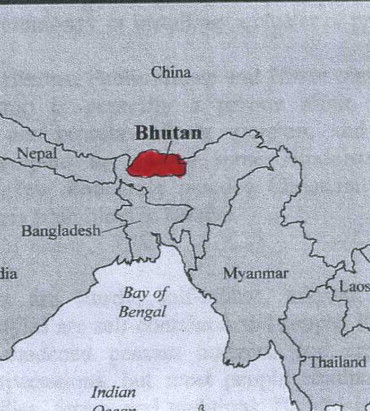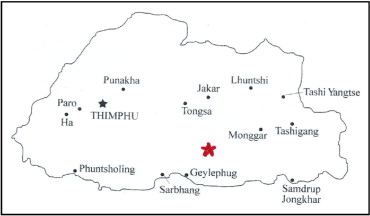In recent years, I have been intrigued by reading about Bhutan ( Figure 1 ) , the Shangri-La Himalayan kingdom wedged between India and China. When an opportunity arose to join the Flying Doctors of America medical mission there, I promptly volunteered, along with my wife, Marilyn.

Bhutan
Several things fascinated me about Bhutan. It is the only country in the world where one cannot buy cigarettes (the fourth king decreed that they were bad for one’s health). Citizens face a 2-year prison sentence if caught smoking anywhere other than the rare designated areas. The king also banned plastic bags, noting that they were not good for the environment. In 2008, he even did away with an autocratic form of government, installing a parliamentary democracy, turning the figurehead kingship over to his son, Jigme Khesar Namgyel Wangchuck, aged 31 years. The latter attended prep school at the Phillips Academy and college at Wheaton and got his master’s degree at Oxford. His favorite sport is basketball, which he plays for an hour multiple times a week. I presented a basketball jersey from Duke University (where I once played) and a signed photo of Duke and Olympic coach Mike Krzyzewski to Tokey Dorji ( Figure 2 ) to pass along to the king as a small wedding gift (he had recently married a pretty 21-year-old “commoner” and was away on his honeymoon). Tokey coached the fifth king in high school and is now secretary general of the Bhutan Basketball Federation, charged with promoting the sport throughout the country.

Bhutan is about the size of Switzerland, 200 miles wide and 90 miles north to south, with a population of <800,000. Until 1962, it lacked a road, school, or hospital. Television did not arrive until 1999, and certain programs are limited (such as pornography, fashion programming, and World Wrestling Entertainment). Upon seeing TV for the first time, 1 viewer was so frightened by a wrestler on the screen that he hid under his bed.
The average yearly income is $1,350. The main occupation for 90% is farming and raising livestock. Almost half of the citizens are under 21 years of age. Of those who go abroad to study, 90% return home to live. The literacy rate has increased from 20% in 1992 to >60% now.
Bhutan is sometimes referred to as an “upside-down country.” The number 13 is considered lucky, for instance. Children sometimes greet visitors by saying, “Bye-bye.” There are more monks than soldiers in the country. Penis paintings adorn many buildings, said to ward off “malicious gossip and evil.” The paintings are rather incongruous in a country so modest that kissing in public is frowned upon. The fourth king had 4 wives, all sisters. Men are required to wear ghos (which are bathrobe-like outfits) during the week. Women wear colorful kiras.
Bhutan was first opened to outsiders in 1972. In the late 1980s, a young local farmer saw his first white person, “a sight so terrifying that he’d run for his life.” An airport opened in 1984. The Druk Airways flight into Bhutan, from Bangkok, Thailand, was said to be the scariest in the world, as the landing strip was short, supposedly like a large driveway, and ringed by mountains. We found these descriptions to be highly exaggerated, as our flights were quite pleasant.
Our medical campsite was in an underserved region in south central Bhutan ( Figure 3 ) . The serpentine roads to that location posed some concerns, after reading that “driving in Bhutan is not for the meek. Hairpin turns, precipitous drop-offs (no guard rails), and a driver who firmly believes in reincarnation makes for a nerve-racking experience.” This was not exaggerated. Although our driver was very careful, there was barely room for 2 vehicles to pass during our 2 days of 12-hour drives. A project was under way to widen our road, by setting off dynamite in the inner stone walls and then bringing in bulldozers to push the boulders down the 2,000- to 3,000-foot outer edge. This periodically led to delays of 30 to 60 minutes.

Thimphu, at an elevation of 7,600 feet and the world’s only capital city without a single traffic light, has a population of 100,000. It can provide culture shock to folks arriving from rural areas, with “the cacophony of dogs barking, horns honking, and jackhammers hammering.”
In recent times, Bhutan has received a lot of publicity for its emphasis on “gross national happiness” rather than gross national product, the focus of most other countries. Murders are almost unheard of. The devout Buddhist people “have such a strong believe in Karma that robbery is unthinkable.” Their ingredients for happiness include giving, loving, and being content with who you are, things a young man learns along his walk to Thimphu in the movie Travellers and Magicians . One hand-painted sign we observed stated, “When the last tree is cut, when the last river is emptied, when the last fish is caught, only then will man realize that he cannot eat money.”
There is only 1 psychiatrist in the whole country. The main problem he deals with is anxiety, probably related to the evolving cultural changes.
The name “Thunder Dragon” relates to a sect of Buddhism. When consecrating a new monastery in the Himalayas in the 12th century, the head monk “heard thunder, which popular belief holds to be the voice of a dragon (druk).”
The Flying Doctors of America
The organization was founded in 1990 by Allen Gathercoal, who has a doctorate in divinity. To date, >7,000 doctors, dentists, physician assistants, nurse practitioners, registered nurses, and pharmacists have provided free medical and dental care to individuals in developing countries.
The mission is straightforward: “to provide medical assistance and hope to as many of the poor and needy as we are able to reach we fly medical and dental teams to wherever the needs takes us.”
In 2011, in addition to Bhutan, the leader took Flying Doctors of American personnel to Guatemala, Peru, Russia, the Solomon Islands, Cambodia, and Myanmar. Each team member contributes to cover the cost of transportation, lodging, and expenses.
The Flying Doctors of America
The organization was founded in 1990 by Allen Gathercoal, who has a doctorate in divinity. To date, >7,000 doctors, dentists, physician assistants, nurse practitioners, registered nurses, and pharmacists have provided free medical and dental care to individuals in developing countries.
The mission is straightforward: “to provide medical assistance and hope to as many of the poor and needy as we are able to reach we fly medical and dental teams to wherever the needs takes us.”
In 2011, in addition to Bhutan, the leader took Flying Doctors of American personnel to Guatemala, Peru, Russia, the Solomon Islands, Cambodia, and Myanmar. Each team member contributes to cover the cost of transportation, lodging, and expenses.
Stay updated, free articles. Join our Telegram channel

Full access? Get Clinical Tree


